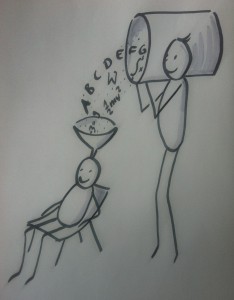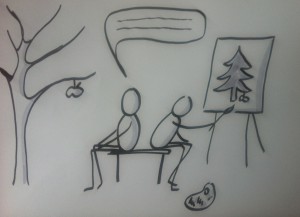
Preparing my workshop on how learning works
As you know, I’m preparing a workshop for teaching assistants in mechanical engineering at Dresden University of Technology. And even though I’ve given similar workshops successfully more than once before, it somehow happened that I changed my plan a bit here, and then changed a bit there, and am now constructing the whole workshop from scratch. Oh well…
Anyway, this is my current plan (which is going to change again more likely than not).
First: Start out with how people learn. It doesn’t work like this:

This is not how learning works!
To talk about constructivism, I am using the examples presented in this blog post. I will talk about the consequences for teaching, for example that no matter how well we explain and describe, it would be really surprising if people understood exactly what we meant.
A nice game, by the way, that illustrates this nicely, was played at my friend Zhenya’s wedding: the couple is sitting, back to back, and each of them gets an identical set of Lego stones. Only that one person gets them assembled and the other person loose, and the person who got the assembled set has now to describe the assembled construction well enough that the other person can recreate it from their pieces! Quite fun, especially if — in contrast to how it worked at Zhenya’s wedding — they don’t define a common frame of reference first…

“…and there are three branches on either side of the tree, and there is an apple hanging from the lowest branch on the right side”
Next, I want to talk about active learning. There are many papers on that that I have presented here on this blog, too, for example Freeman et al. (2014), Smith et al. (2009), or Crouch et al (2004). All those certainly deserve to be mentioned.
Then, I want to go into motivation, and you’ve seen a couple of blog posts on this recently (for example on why do students actually engage in learning activities or how do boundary conditions influence learning).
Obviously, the way those three topics are presented will not be a lecture, but I will be using various active learning methods (currently, there are a dozen on my list!). And while we are talking about those three topics and using those 12 different methods, we will always link back the current method to the theory of learning or motivation we are talking about at that moment.
Quite a tall order, you say? Well, yes. But all the parts have worked really well individually, so I am pretty confident that they will work even better when combined this way. I’ll let you know! And if you want to pre-book me to do a workshop where you are at, just get in touch! :-)